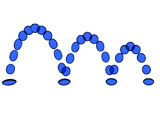
Animationsprinzipien für 3D Computeranimation
John Lasseter hat die Grundprinzipien der Disney-Animation 1987 zusammengefasst und gezeigt, wie diese auf die Computeranimation übertragen werden können. Das Prinzip Solid Drawing ist für 3D Computeranimation nicht relevant.
- Squash and Stretch - defining the rigidity and mass of an object by distorting its shape during an action
- Timing and Motion - spacing actions to define the weight and size of objects and the personality of characters
- Anticipation - the preparation for an action
- Staging - presenting an idea so that it is unmistakebly clear
- Follow Through and Overlapping Action - the termination of an action and establishing its relationship to the next action
- Straight Ahead Action and Pose-to-Pose Action - The two contrasting approaches to the creation of movement
- Slow In and Out - the spacing of the in-between frames to achieve subtlety of timing and movement
- Arcs - the visual path of action for natural movement
- Exaggeration - Accentuating the essence of an idea via the design and the action
- Secondary Action - the action of an object resulting from another action
- Appeal - creating a design or an action that the audience enjoys watching
John Lasseter - Principles of Traditional Animation Applied to 3D Computer Animation
Isaac v. Kerlow erweitert in dem Buch "The Art of 3D Computer Animation and Effects" die Animationsprinzipien für 3D Computeranimation durch folgende Aspekte:
- Visual styling - Der "Look" der Animation ist erheblich abhängig von Aspekten wie Rendering und Animationstechnik. In vielen Fällen muss auf Grund der Komplexität ein Kompromiss eingegangen werden.
- blend motion - Unterschiedliche Animationen können kombiniert werden. Generell werden folgende Animationsstile definiert: cartoon physics, realistic cartoon, realistic human motion. Animationen können über Motion Controll Systeme auf Charaktere übertragen werden oder durch Rotoskoping und Analyse erstellt werden.
- Cinematography - Prinzipien, die aus dem Bereich Film bekannt sind, gelten auch für 3D Computeranimationen.
- Facial Animation - Bei Charakteranimationen ist die Gesichtsanimation eines der wichtigsten Gestaltungselemente. Über das Gesicht bzw. besonders über die Augen werden Stimmungen und Gefühle transportiert. Durch die umfangreichen Möglichkeiten für Gesichtsanimation (blend shape bzw. morping) liegt hier ein großes Potential.
- user-controlled animation - durch interaktive 3D Echtzeitanwendungen können vorproduzierte Animationssequenzen wie Walk Cycles oder Sprunganimationen gesteuert werden. Dadurch lassen sich virtuelle Charaktere interaktiv steuern. Computeranimationen mit Game-Engines bzw. mit interaktiven Echtzeitanwendungen zu produzieren, könnte in Zukunft immer mehr an Bedeutung erlangen. So beschäftigt sich z..b die Academy of Machinima arts & scienes bereits seit 2002 damit, Filme mit Hilfe von handelsüblichen Computerspielen zu produzieren.

 Verlauf
Verlauf

 Alle Kapitel anzeigen
Alle Kapitel anzeigen voriges Kapitel
voriges Kapitel